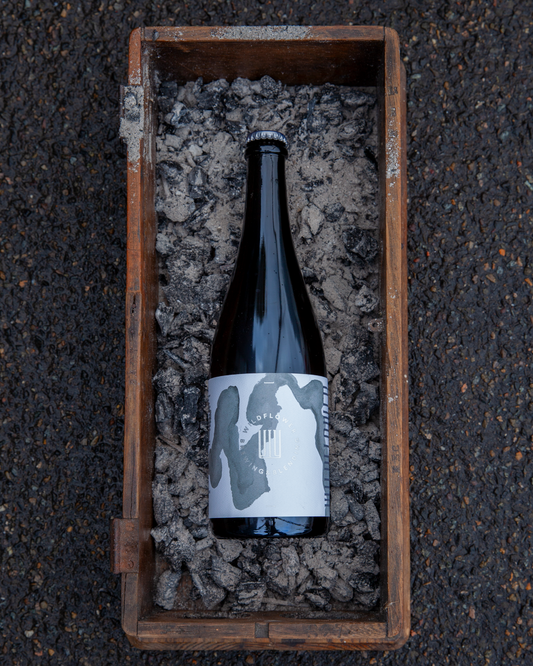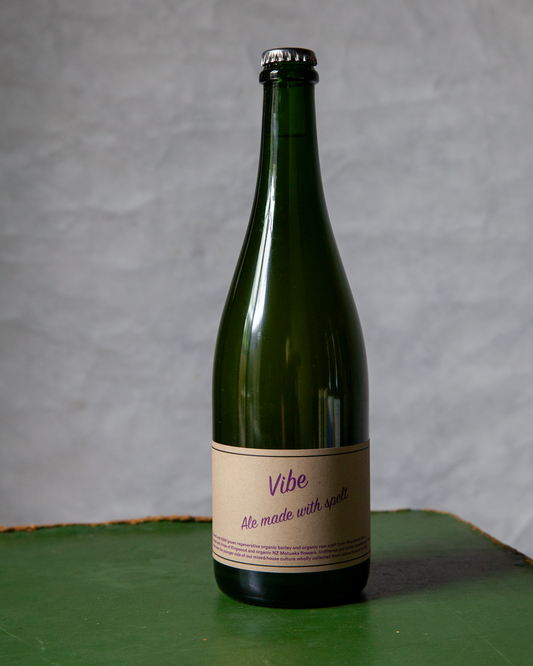We are excited to announce that both St Florence 2018: Sauvignon Blanc and St Florence 2018: Pinot Noir will be available at our cellar door and online (at 2pm) on September, 7 2018.
St Florence is an Australian Wild Ale refermented with wine grapes. It is named for Topher and his wife's first daughter and released around Florence's birthday. The Saint Florence was a 7th century abbess from Cartagena, Spain.
Our first release of St Florence was in October of 2017, about a month after my daughter was born, made with Sauvignon Blanc grapes. In 2018 with a little growth and a little better scope with what we were setting out to achieve, we decided to make variants of St Florence using two different grape varietals. This beer, in both variants, aims to bring to light the interaction between native wine and beer fermentations. We as a brewery are heavily influenced by the winemaking world, well the part of it that ferments with native yeasts and doesn’t use additives or excessive procedures. We are continually inspired by its producers to increase the thought and integrity in our beer. It should be no surprise that these wine-grape refermented beers are a major focus for us and provoke year-long conversations about how we tweak them at the next vintage.
In 2018, we received beautiful fruit for both of these beers from DeSalis Winery in Orange, NSW… the same place as for St Florence 2017. They were hand picked as whole bunches (clusters) into semi-sealable 400-450kg bins, purged with CO2, wrapped up to seal in the CO2 and placed in a coolroom overnight before being cold-transported to Wildflower. The decided to have the Pinot picked for rosé, so just a little early, to accentuate the bright acid potential of this fruit while the Savvy was left for a few weeks longer on the vine to achieve a fuller ripeness, similar to the ’17 crop. Upon receiving the fruit, we did a number of things…
For the Pinot Noir grapes, we immediately pressed nearly 2 barrels worth of juice directly into neutral French Oak barrels for fermentation and ageing to make a fresh rosé. You can read about this wine and its story here. The rest of the fruit was put directly into a stainless steel upright vessel as whole bunches, stems and all before being sealed and left untouched for 3 weeks. By doing this, we sent the fruit through what is known as a carbonic maceration, or ‘cab mac’. This technique is very common particularly in wines from Beaujolais. This technique allows not only for fermentation to start by the native yeast on the skin of the grape but also more importantly for fermentation to begin literally inside the grape berry itself. Imagine every little single grape being its own little fermentation vessel with a little tiny ferment happening inside it… thats what’s going on. This technique produces bright and crunchy primary fruit characters in wine. For our beer, we want both of these things. Firstly, we want St Florence: Pinot Noir to be a true co-fermentation of both native yeasts from our house mixed culture and native yeasts from the skins of the fruit. Hence our lengths to preserve a microbial lack-of-diversity from the field to our brewery. Secondly, we want to express the bright, juicy flavours that a grape like Pinot Noir can bring to the resultant beer. Cab mac also begins to naturally break down the skins of the fruit so that when blended with beer, they will eventually burst and release any leftover sugars for fermentation by the beer yeasts. In this way we do not need to freeze, crush or in any other way intervene with a perfectly fine and natural process. During the maceration, some of the berries burst under weight of the other grapes, releasing fermenting juice which falls to the bottom of the tank and continues to ferment in contact with the stalks and exterior skins of other berries. Its a cool process because the carbon dioxide let off by this free juice at the bottom fills the rest of the vessel and blankets all of the fruit from oxidation as well as helping kick off fermentations in sluggish berries.
For the Sauvignon Blanc, all the fruit we received was put directly into stainless steel as whole bunches, sealed and left alone for a three week long carbonic maceration. The savvy cab mac was so familiar to Florence ’17… every time I went past I got a whiff of pungent, sweet acids and high esters. It was really nice to know that we were making something reminiscent of last year’s beer.
After the Pinot’s 3 weeks, we opened the bottom of the vessel and moved the liquid, now essentially wine, to barrel. We then started to dig out the intact fermenting bunches that hadn’t burst and basket pressed enough of them to fill the wine barrel. The remaining bunches (about 1/2 of what we had started with) stayed inside the cab mac vessel. We sealed it once again and moved two barrels of aged mixed culture golden beer onto the grapes. 1706 was a reclaimed barrel of our fated Gold Blend #2, a blend we never released because were unhappy with it, but put back to barrel to age. With this we blended barrel #1714, a 10 month old Gold barrel. These were blended in on the ides (15th) of March. The beer was in contact with the fermenting grapes for over 3 months until on June 20th, the vessel was emptied and put directly to bottle at 5% ABV and 0.2P (1.001 SG). The flavours of this beer were so delicate we decided not to blend in a third barrel as we normally do for our fruit beers. Thus we only yielded around 400 bottles of this variant this year. At release, the beer has a spice dominant nose of cumin and woody cedar, lifted by red cherries and stalk. The front palate is dominated by the Pinot fruit: redcurrant and raspberry blended with alpine herbs and cellar funk that results in a beer of true subtly and nuance. The way the beer evolves in the glass is a testament to the thoughtful handling and blending of the beer.
After the savvy’s cab mac, we drained the fermenting free-run juice/wine into the second rosé barrel. This wine, a blend of Pinot Noir and Sauvignon Blanc, has not yet been released but we intend to later down the track. We were left with an empty tank of fermenting bunches which were soon drowned in a single 9 month old puncheon of our Lager Beer wort fermented only with our NSW culture. These two were blended together on 11 April 2018 and left together to co-ferment for nearly 3 months when on July 3 we blended in barrel #1777, an 8 month old barrel of a similar NSW culture fermented lager beer wort. It was packaged on the same day at 5.5% ABV and 0.01P (1.000 SG). We packaged just under 1,000 bottles of St Florence: Sauvignon Blanc. At release, this beer has a strong vinous nose with savvy characters of lemon citrus and grassy herbaceous complemented with yeasty, funky aged beer aromas. The front palate is dominated by citrus and melon. A phenolic grip provides a structural depth to the beer and helps integrate the strong influence of the fruit with the complexity of the aged beer. More complete than Florence ‘17 the ‘18 will reward those who allow it to continue to age in bottle.
These two beers, along with the Pinot Rosé, will be released on Friday, September 7th at 2pm AEST. The next day, we will be hosting Enmore BBQ friends Bovine & Swine to cook at cellar door on a day we are affectionally calling St Florence day. Please see our facebook event for more information on this.

Both St Flo's, along with our other fruit re-ferment beers this year, was packaged in 375ml quarter-magnum bottles. There will be a 6 bottle per person limit to purchase online and at the cellar door. We will make around 200 bottles of St Florence: Pinot Noir and 400 bottles of St Florence: Sauvignon Blanc available online while the remaining will be sold at the brewery. Outside of special events, we do not expect to distribute this beer outside of the cellar door and online.
These beers embody everything we at Wildflower are about: family, great beer, interesting fermentations, diverse interests and community.
-topher





